15 Strategies to Get Real Estate Leads

Heading 1
Heading 2
Heading 3
Heading 4
Heading 5
Heading 6
Lorem ipsum dolor sit amet, consectetur adipiscing elit, sed do eiusmod tempor incididunt ut labore et dolore magna aliqua. Ut enim ad minim veniam, quis nostrud exercitation ullamco laboris nisi ut aliquip ex ea commodo consequat. Duis aute irure dolor in reprehenderit in voluptate velit esse cillum dolore eu fugiat nulla pariatur.
Block quote
Ordered list
- Item 1
- Item 2
- Item 3
Unordered list
- Item A
- Item B
- Item C
Bold text
Emphasis
Superscript
Subscript
15 Strategies to Get Real Estate Leads
%20(1).png)
N.Suresh
Join us on November 6th as Mr. Yash Mishra, Product Manager, Fatakpay, reveals the precise strategies that eliminates the speed trap and guarantees a 30% conversion boost.
In real estate, your business lives or dies by your pipeline, and to get leads for real estate agents to fill your pipeline requires more than being good at selling - you need a system.
Nine out of ten homebuyers start their search online, scrolling listings at midnight, comparing agents like they compare Netflix shows. And if your lead pipeline isn’t organized, automated, optimized, and always on, you’re missing opportunities before you even wake up.
Whether you’re new to the business or scaling your portfolio, lead generation for real estate agents is the foundation of your growth. In this blog, we’ll break down 15 practical, proven strategies to get leads in real estate, without burning out or wasting money on low quality prospects.
15 Proven Strategies to Create Leads in Real Estate
The best real estate agents treat lead generation like a finely tuned system blending technology, psychology, and strategy to attract, qualify, and convert prospects consistently. From technical SEO to AI-driven prospecting, each tactic plays a specific role in building a predictable, high-quality pipeline.
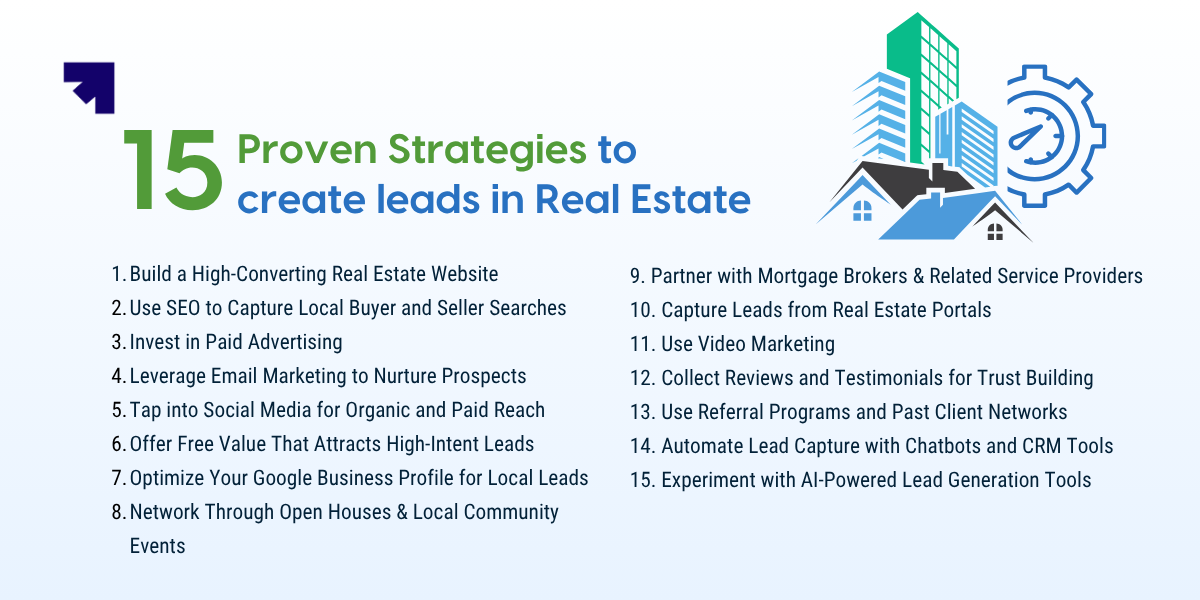
Here’s a comprehensive breakdown of the 15 most effective strategies:
1. Build a High-Converting Real Estate Website
Your website is your 24/7 sales agent, and it should capture leads beyond showing mere listings. Too many agents settle for a generic “about me” page with multiple listing service (MLS) feeds, but if your site isn’t built to capture and nurture leads, you’re losing buyers to competitors before they even schedule a tour.
Here’s what changes that:
- Design a mobile-first, lightning-fast site, aiming for under 2.5s load time with a Content Delivery Network (CDN) like Cloudflare.
- Integrate Internet Data Exchange (IDX) /MLS feeds using plugins like IDX Broker, but create unique property landing pages with custom meta tags and schema so you rank in search.
- Add VideoObject JSON-LD for video tours and frequently asked questions (FAQ) schema for buyer questions.
- Implement AI chatbots to answer FAQs and capture leads 24/7.
- Add lead magnets like “Book a Viewing” or “Get a Free Home Valuation.”
- Push every inquiry into customer relationship management (CRM) with automated workflows for instant follow-up.
Example: You can integrate IDX via Placester and add a chatbot to qualify leads automatically. This creates a frictionless browsing experience and can double your inquiries without extra manual follow-ups.
This works because a high-performing site builds trust and guides users toward action without manual follow-ups, and makes it easier to get leads for real estate in your area.
2. Use SEO to Capture Local Buyer and Seller Searches
Most buyers don’t search for “real estate agent”; they search for “2BHK near (school name)” or “best neighborhoods in (area location).” Ranking for hyperlocal keywords makes you the name they find.
Here’s how to own local searches:
- Create neighborhood pages with school data, commute times, and hyperlocal insights.
- Implement the Real Estate Listing and Geo Coordinates schema to tell Google exactly what you’re selling.
- Generate dynamic XML sitemaps for listings and use canonical tags to avoid duplicate multiple listing service (MLS) content.
- Monitor click-through rates (CTRs) in Google Search Console and refine copy on underperforming pages.
- Combine content with technical optimization to dominate local searches.
Example: You can create a landing page like “Best Starter Homes in Dallas Uptown” with drone images, recent sales data, and school ratings. Over time, this positions you as a hyperlocal authority, driving free leads from people searching for exactly what you offer.
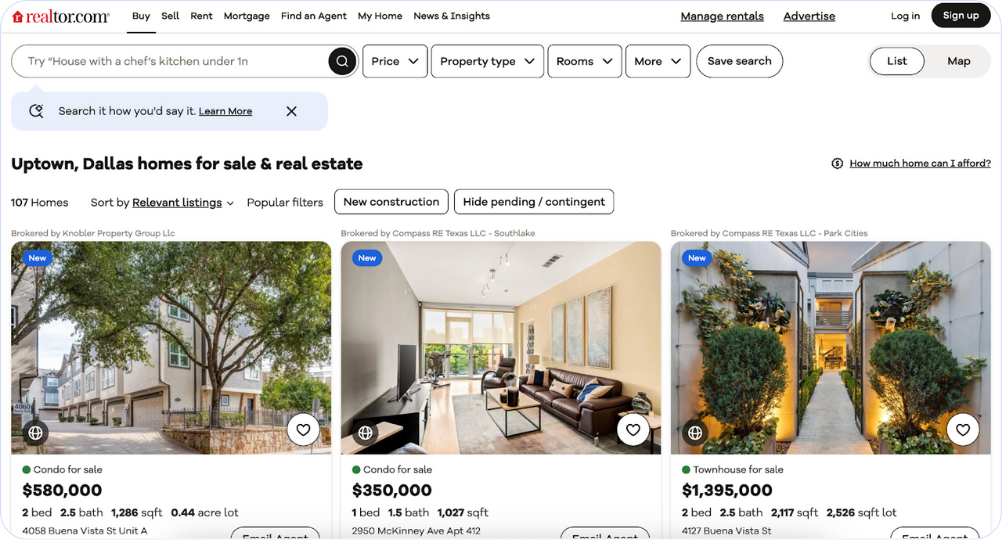
This is one of the most effective lead generation ideas for real estate because it builds authority and attracts organic leads. Simply because hyperlocal SEO turns your site into a resource beyond a listings hub, attracting serious buyers and sellers without paying per click.
3. Invest in Paid Advertising
Organic reach is powerful but slow. But if you’re breaking into a competitive market or want instant visibility, ads are the fastest way to get in front of your buyers.
You can:
- Use Google Ads for high intent searches like “sell my home in (city).”
- Retarget website visitors with Instagram carousel ads and Facebook Lead Form Ads for easy data capture.
- Set location bid modifiers and stick to phrase or exact match for conversion-heavy keywords like “sell my home”, “home for rent” etc
- Track every call with dynamic number insertion (DNI) and route leads into CRM workflows instantly.
Example: You can create a campaign that only shows listings to buyers searching for “Downtown condos” in their price range, then retarget them with reels showing interiors. This can reduce your ad spend waste and cut cost per lead by up drastically.
Paid ads let you laser-target buyers and sellers, speeding up your pipeline to get leads in real estate faster by reaching people actively considering a move.
4. Leverage Email Marketing to Nurture Prospects
In real estate, buying or selling a home is rarely a one-click decision. Prospects often browse listings for months before they’re ready to act, which is why email remains a goldmine. A well-structured email marketing strategy keeps you top-of-mind, so when they’re finally ready, you’re the first call they make.
Here’s how :
- Start by segmenting your email lists into first-time buyers, seasoned investors, and homeowners looking to sell because all have different needs.
- Build drip campaigns offering local market insights, mortgage tips, and curated listings.
- Automate follow-up responses so every download, showing request, or valuation inquiry triggers a personalized follow-up.
Example: After a lead downloads a “First-Time Buyer Checklist,” send them a 5-part email series about saving for a down payment, mortgage pre-approval, and local market insights. This builds trust over weeks and converts casual browsers into buyers.
This can work to get leads in real estate, because email nurtures trust over time, shortens the sales cycle, and positions you as a market expert.
5. Tap into Social Media for Organic and Paid Reach
Social media is one of the fastest ways to get leads for real estate, as it can be a stage for your brand personality and expertise.
You can:
- Use Instagram reels and YouTube shorts to share short, authentic snippets like a behind-the-scenes look at staging, a market insight, or a casual Q&A.
- Post carousel-style neighborhood guides to establish authority and create evergreen content.
- Pair this with boosted ads targeting zip codes, income brackets, or relocation markets.
- Hosting live Q&As on Instagram or Facebook also helps you build trust in real-time.
Example: Post a reel showcasing a cozy home under $300k and boost it to people in your city aged 25 to 40. The video format can spark engagement and DMs, turning likes into qualified leads.
This works because people don’t just buy homes; they buy from people they trust, and social media is a powerful tool for lead generation for real estate agents, making you relatable.
6. Offer Free Value That Attracts High-Intent Leads
Free tools are the best lead magnets because they give prospects something tangible before they even speak to you. Instead of generic “Contact Us” forms, create interactive value.
You can:
- Add a “What’s my home worth?” estimator powered by APIs like Zillow’s Zestimate
- Publish downloadable guides for first-time buyers or investors, or create hyperlocal market reports that demonstrate your insider knowledge.
- Share hyperlocal market reports to position yourself as the go-to expert.This ensures every download turns into a lead you can nurture.
Example: Create a “What’s my home worth?” landing page with a free valuation tool and anyone using it must enter their email, instantly adding them to your database. These high-intent leads often convert faster than cold inquiries.

This works greatly because people trust those who educate them first. Providing personalized insights positions you as a thought leader.
7. Optimize Your Google Business Profile for Local Leads
For many buyers, your Google Business Profile (GBP) is their first impression of your business. A half-filled profile with no updates is a red flag, while a polished, active one drives instant credibility.
You can,
- Ensure your NAP (Name, Address, Phone) data is accurate, and include your service areas and specialty keywords in the description.
- Upload geotagged listing photos, encourage location specific reviews and use google posts to highlight open houses or new listings.
- Track traffic and engagement through the GBP Manager dashboard.
- Regularly post updates, listings, and offers, and encourage clients to leave reviews with location-specific keywords.
Example: Upload a photo of every home sold, add “Top Realtor in [City]” in your bio, and encourage reviews mentioning neighborhoods. This strategy boosts your ranking on Google Maps and drives calls directly from search results.
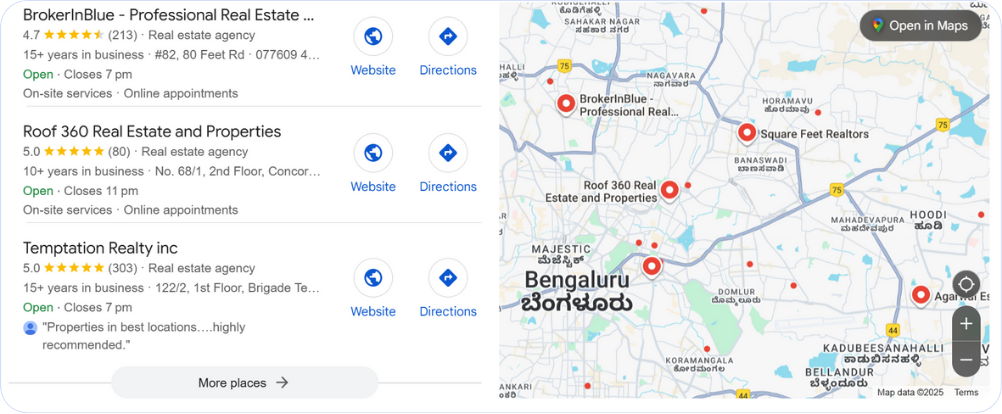
This works great because a high-performing GBP earns you top placement in Google’s local map pack, helping you get leads in real estate directly from search results where serious buyers are already searching.
8. Network Through Open Houses and Local Community Events
Digital strategies dominate, but nothing replaces a handshake and face-to-face conversation. Open houses and local events allow prospects to meet you in a natural, low pressure setting which is one of the oldest yet most effective lead generation ideas for real estate.
You can:
- Host open houses with digital sign-in sheets linked to your CRM.
- Partner with local event organizers or sponsor community fairs to build brand recognition.
- Distribute flyers with QR codes that lead directly to property listings or virtual tours.
Example: At an open house, add a digital sign-in form via QR code so every guest joins your follow-up list. At a local farmers’ market, sponsor a booth with free market guides and these connections create trust and future referrals.
This works because real estate is still a relationship business, and in-person interactions build trust faster than cold outreach ever will.
9. Partner with Mortgage Brokers and Related Service Providers
Strong partnerships are a shortcut to trust. Buyers often consult mortgage brokers, insurance agents, or inspectors first, so position yourself as their recommended agent.
You can:
- Form co-marketing campaigns, like a free “Financing Your First Home” webinar with a mortgage partner, or distribute co-branded guides that include your services.
- Use LinkedIn to create intentional partnerships and track lead referrals through your CRM.
Example: Host a co-branded webinar with a mortgage broker on “How to Secure the Best Loan in 2025.” Attendees opt-in with their email, giving you qualified, motivated buyers ready for property tours.
This can work because partner networks open doors to pre-qualified leads already deep in their buying journey.
10. Capture Leads from Real Estate Portals
Major portals like Zillow, Realtor.com, or 99acres are where buyers actively shop, and that intent is gold. However, competition is fierce, and so optimization is key.

You can:
- Claim and complete your agent profile with verified reviews, a professional bio and branding elements.
- Invest in premium listings or local advertising to appear higher in search results.
- Respond to portal leads within minutes because speed directly impacts your ranking and conversion rate.
Example: Integrate these portals with your Real Estate CRM to automatically capture all lead details in one place.
11. Use Video Marketing
Video lets buyers experience homes emotionally, something photos simply can’t achieve. It also helps you establish authority while showcasing your personality.
You can:
- Shoot property walkthroughs with a gimbal or smartphone, edit them into short reels, and repurpose them into long-form video content.
- Showcase neighborhood features (parks, schools, cafes) to sell the lifestyle.
- Use subtitles and captions to improve accessibility and reach.
Example: Film a 1-minute “Top 3 Streets to Live On in (City)” video and post it on YouTube Shorts and Instagram. This triples your exposure and positions you as a trusted local expert.
Video builds a connection faster than text or photos before they even schedule a showing, shortening the decision-making process.
12. Collect Reviews and Testimonials for Trust Building
Social proof sells because buyers trust other people’s experiences with you more. Actively gathering reviews is one of the most powerful sales tools you have.
You can:
- Make it a habit to request a review immediately after closing while the client experience is fresh.
- Post testimonials on your website, GBP, and Instagram highlights.
- Video testimonials add even more credibility and are perfect for social campaigns.
- Display testimonials on your site, GBP, and social media.
Example: After closing a deal, send clients a thank-you package and a direct review link. Post their testimonial on your site and social media. This consistent effort builds credibility, making future buyers choose you faster.
This works best because reviews dismantle skepticism and help prospects feel confident about choosing you.
13. Use Referral Programs and Past Client Networks
Your happy clients can be your strongest salesforce. A thoughtful referral program turns one closed deal into two or three more.
You can:
- Send thank-you gifts or gift cards for successful referrals.
- Organize annual client appreciation events to keep relationships warm.
- Keep your network engaged through exclusive email newsletters featuring listings and market updates.
Example: Send a handwritten card with a $50 gift card for every referral. Organize a yearly client appreciation dinner and highlight success stories. These nurture loyalty, making clients more likely to refer to multiple friends.
This can be a great strategy because referrals are cheaper to acquire, warmer to convert and create a steady flow of high-quality leads.
14. Automate Lead Capture with Chatbots and CRM Tools
The moment a lead fills out a form, the clock starts ticking. AI chatbots can respond instantly, while a robust CRM ensures every interaction is logged and tracked.
You can:
- Deploy chatbots on your site to answer FAQs, schedule viewings, or guide visitors through listings.
- Integrate with a CRM to segment leads based on intent, property interest, or location.
- Automate email and SMS reminders so no lead falls through the cracks.
Example: Add an AI chatbot to your site to answer common questions and book appointments. Pair it with a CRM like Corefactors to auto-tag leads and trigger SMS follow-ups. This reduces manual workload while increasing conversions.
It simply works because speed is everything and automation keeps your business responsive 24/7, even while you sleep.
15. Experiment with AI-Powered Lead Generation Tools
AI analyzes your buyer behavior and predicts who’s most likely to convert already.
You can:
- Use AI tools for lead scoring based on their browsing behavior, budget, and engagement history.
- Personalize property recommendations automatically and use conversational AI to qualify prospects before they reach you.
Example: Use Corefactors to score leads based on engagement behavior, like how many listings they view. Send them personalized property suggestions automatically, and this can turn browsing patterns into actionable insights and save hours of guesswork.
Online vs. Offline Lead Generation for Real Estate
In real estate, relying only on online or offline lead generation is like building a house with one wall. The most successful agents blend digital precision with offline relationships to create a consistent pipeline.
Online tactics are scalable, data-driven lead generation.
For instance,
- SEO (Search Engine Optimization) turns your website into a magnet for high intent leads. By ranking for local keywords like “apartments near Brigade Road,” you capture buyers and sellers already searching for solutions.
Benefit: Free, compounding traffic that builds authority over time. - Paid ads (Google and Facebook) give you immediate visibility. Targeting options allow you to reach buyers by location, interests, or recent behavior (like searching mortgage rates).
Benefit: Instant exposure, measurable ROI, and scalable campaigns to get leads for real estate. - Email automation keeps you top-of-mind for months. Automate drip campaigns that deliver listings, financing tips, and market updates to nurture leads.
Benefit: Low-cost way to warm cold leads and shorten decision cycles.
Whereas, offline tactics are relationship-driven lead generation. For instance:
- Networking events and open houses: Face-to-face events create trust that no email campaign can replicate. Hosting open houses or sponsoring local events helps you meet people where they are.
Example: A well-promoted open house with QR code sign-ins can capture dozens of local leads in a day. - Referrals and direct mail: Past clients and neighbors are powerful advocates. A handwritten postcard with a recent sale in their area feels personal and stands out in a world of email overload.
Benefit: Builds community credibility and leverages word-of-mouth influence to get leads for real estate.
When and why each works to get leads for real estate:
| Method | Best For | Strengths | Weaknesses |
|---|---|---|---|
| SEO and Paid Ads | Scaling lead generation fast | High visibility, measurable ROI, 24/7 reach | Requires ongoing budget and optimization |
| Email Automation | Nurturing long-term leads | Personalization at scale, cost-effective | Requires a strong content strategy |
| Networking and Events | Building trust in local markets | Face-to-face relationships, high conversion rates | Time-intensive, limited reach |
| Referrals and Direct Mail | Converting warm audiences | High trust factor, strong local branding | Slower growth, harder to scale |
- Use online tactics for reach, scalability, and instant visibility.
- Use offline tactics to build deep trust, strong referrals, and a lasting reputation.
- A well-balanced mix ensures you’re not dependent on algorithms or market fluctuations.
Best Tools for Real Estate Lead Generation
The right tech stack turns your lead generation from a manual grind into a smooth, scalable engine. Instead of juggling spreadsheets or chasing messages across platforms, these tools bring everything into one ecosystem, helping you to get leads for real estate, nurture them and close deals faster.
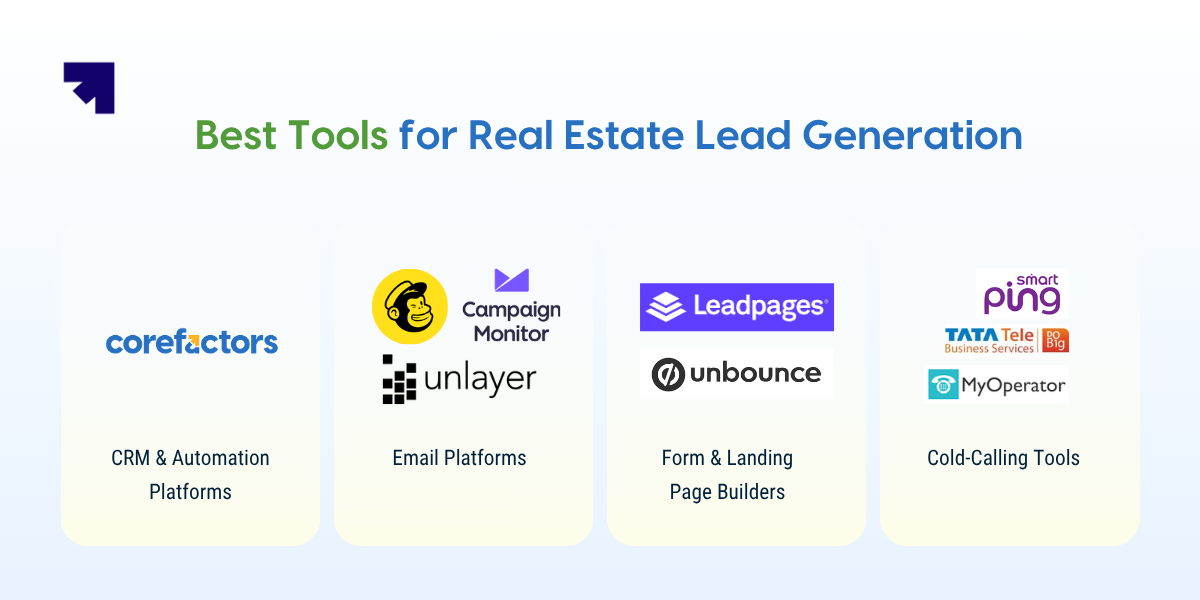
Here’s what to invest in to get leads for real estate:
1. CRM and Automation Platforms
A good CRM is your command center; every lead, inquiry, and follow-up flows here.
- Corefactors CRM: Purpose-built for real estate teams, it captures leads from websites, portals, ads, and calls into one dashboard. Its AI-driven lead scoring prioritizes the hottest prospects, while automated SMS/email workflows ensure nobody slips through the cracks.
You also get actionable insights (like tracking which properties they viewed), making follow-ups timely and hyper-personal.
2. Email Platforms
Email remains one of the best nurturing channels for long sales cycles.
- Mailchimp: Easy drip campaigns and property updates with analytics.
- Campaign Monitor: Beautiful templates, perfect for branded newsletters.
- Unlayer: Drag-and-drop design for polished property announcements.
3. Form & Landing Page Builders
Your website visitors won’t convert without strategic landing pages.
- Unbounce: Create high-converting property landing pages with A/B testing.
- Leadpages: Simple, mobile-friendly landing pages for open house sign-ups.
- Landing: Great for multi-step lead capture forms.
4. Cold-Calling Tools
Cold calls aren’t dead, they’re transformed into smarter tools like Tata Tele, MyOperator, and SmartPing help agents place, record, and analyze calls at scale.
- Tata Tele: Automates outbound campaigns and call tracking.
- MyOperator: Cloud telephony solution to manage large call volumes.
- SmartPing: Provides real-time call analytics and click-to-call functionality.
When integrated with Corefactors CRM, these tools create a complete follow-up ecosystem:
- A lead fills out a form or downloads a market report
- The CRM auto-assigns it to an agent
- The calling tool triggers a click-to-call or auto-dial, logs the conversation and updates lead status instantly
This means no lead is ever forgotten, and every conversation is part of a centralized client history for smarter decision-making
Measuring the Success of Your Real Estate Lead Generation Strategy
Most real estate teams bleed revenue because leads get scattered across emails, spreadsheets, and phones. A fully connected stack like landing pages to CRM to calling creates a frictionless funnel:
capture → qualify → follow up → close.
This is where Corefactors shines: it acts like a glue that ties ads, portals, calls, and automation into one platform, saving you time and boosting ROI.
But leads are only as valuable as the deals they turn into. That’s why measuring your results is just as critical as generating leads in the first place. Without clear metrics, you’re operating blind, guessing what works rather than doubling down on proven tactics.
Start with three non-negotiables:
- Conversion Rate: How many leads actually book viewings or sign contracts? If you’re converting fewer than 5%, it’s time to reassess your lead sources.
- Cost Per Lead (CPL): Calculate total marketing spend divided by leads generated. Paid ads are great, but they should drive high-quality leads at a sustainable cost.
- Lead Quality: Not every lead is worth chasing. Track how many become genuine opportunities using AI-driven lead scoring in platforms like Corefactors.
Use CRM dashboards to see where leads drop off, Google Analytics for traffic attribution, and email open/click rates to fine-tune your nurturing campaigns. Set clear benchmarks like “20% open rate” or “10% appointment booking rate” and run A/B tests to optimize.
Also, don’t wait for quarterly reports to act. Weekly snapshots and small experiments keep your pipeline healthy and evolving.
Building a Sustainable Real Estate Lead Pipeline
A pipeline that only works when you’re running ads or knocking on doors isn’t a pipeline, it’s a hustle treadmill. Sustainability in lead generation means building systems that bring in prospects consistently, not just when you have time to focus on marketing.
Commit to a weekly cadence:
- Mondays: Update listings and post new market insights.
- Wednesdays: Run lead-nurturing emails or follow-up calls.
- Fridays: Host a Q&A live stream or attend a local networking event.
Mix online and offline tactics to diversify your funnel. An open house builds trust in person, while AI-powered tools help you scale follow-ups automatically. And don’t be afraid to experiment; try vertical videos, predictive lead scoring, or even interactive neighborhood guides to stand out.
Here’s your challenge: pick two new tactics from this guide and implement them this month. Track your results in a CRM like Corefactors to see what sticks, then refine. Over time, your lead pipeline will grow into a strategic pipeline to get leads in real estate.
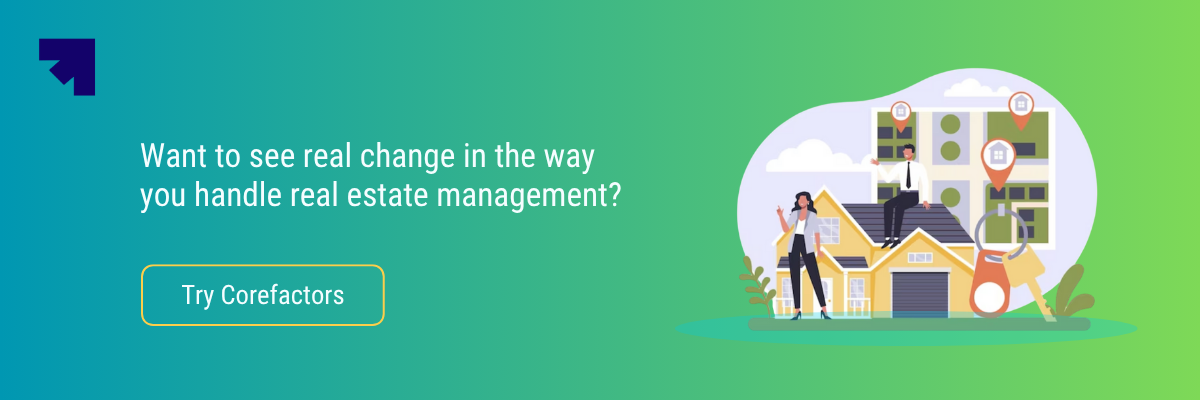
Heading 1
Heading 2
Heading 3
Heading 4
Heading 5
Heading 6
Lorem ipsum dolor sit amet, consectetur adipiscing elit, sed do eiusmod tempor incididunt ut labore et dolore magna aliqua. Ut enim ad minim veniam, quis nostrud exercitation ullamco laboris nisi ut aliquip ex ea commodo consequat. Duis aute irure dolor in reprehenderit in voluptate velit esse cillum dolore eu fugiat nulla pariatur.
Block quote
Ordered list
- Item 1
- Item 2
- Item 3
Unordered list
- Item A
- Item B
- Item C
Bold text
Emphasis
Superscript
Subscript
Frequently Asked Questions (FAQs)















.png)

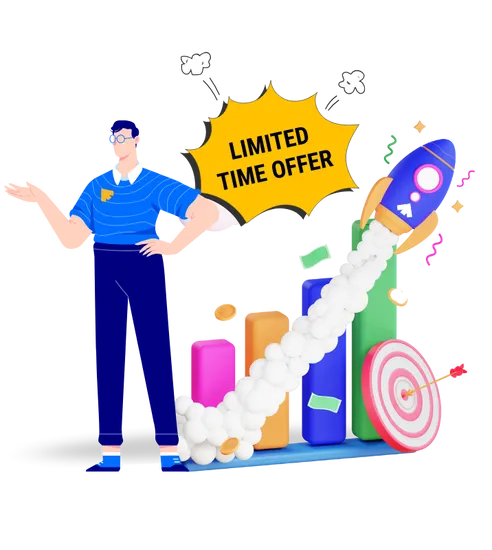











.png)




.png)